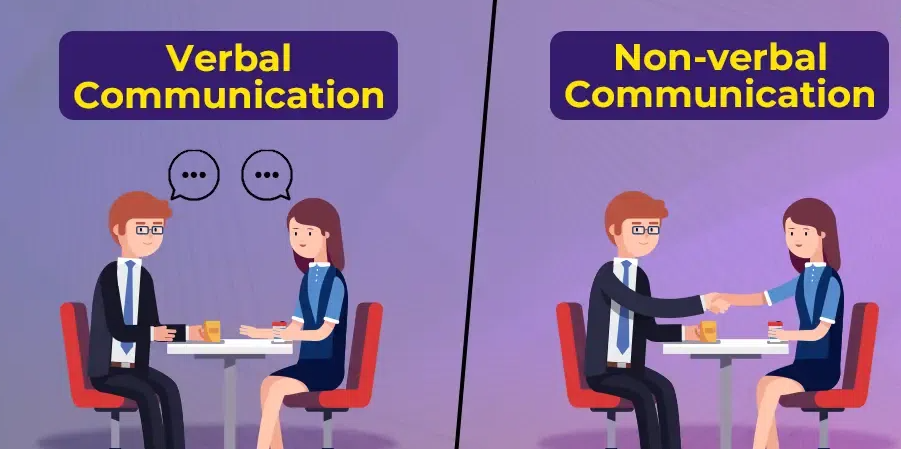Verbal Communication vs Non-Verbal Communication: Understanding the Differences

Effective communication is essential in both personal and professional interactions. It plays a vital role in building relationships, conveying messages, and fostering understanding. There are two primary types of communication: verbal and non-verbal. While both are crucial, they serve different purposes and are often used in tandem to enhance understanding. This blog will explore the differences between verbal and non-verbal communication, their respective importance, and how they can complement each other.
What is Verbal Communication?
Verbal communication involves the use of words, either spoken or written, to convey a message. It is a straightforward way of communicating information through language.
1. Characteristics of Verbal Communication
- Words and Language: Verbal communication relies on language and vocabulary, allowing for precise information to be shared.
- Clarity: It allows the speaker to express their thoughts directly, and words can be carefully chosen to match the context.
- Tone and Pitch: In spoken communication, tone and pitch also influence how the message is received, such as whether the speaker seems confident or hesitant.
2. Examples of Verbal Communication
- Face-to-face conversations: Talking directly to someone in person.
- Phone or video calls: Communicating over a phone or video chat.
- Emails and written messages: Using written text to convey thoughts.
3. Advantages of Verbal Communication
- Immediate Feedback: Verbal communication allows for instant feedback, which helps clarify misunderstandings.
- Efficiency: It is often quicker than non-verbal methods, especially when detailed information is involved.
What is Non-Verbal Communication?
Non-verbal communication is the transmission of messages without the use of words. It includes facial expressions, gestures, posture, and body language that often convey emotions and attitudes.
1. Characteristics of Non-Verbal Communication
- Facial Expressions: These can indicate feelings such as happiness, sadness, or confusion, and often reinforce or contradict verbal messages.
- Gestures and Body Language: Movements of the body, such as hand gestures or posture, often convey important information that words may not express.
- Eye Contact: Maintaining or avoiding eye contact can signal confidence, interest, or discomfort.
- Proxemics: This refers to the physical distance between communicators, which can indicate levels of intimacy or formality.
2. Examples of Non-Verbal Communication
- Smiling or frowning: These expressions communicate emotions without the need for words.
- Nodding or shaking your head: Indicates agreement or disagreement.
- Crossed arms: Can convey defensiveness or resistance.
3. Advantages of Non-Verbal Communication
- Adds Emotional Depth: Non-verbal cues can provide emotional depth to verbal communication, making the message more expressive.
- Universal Understanding: While language barriers may exist, many non-verbal cues like smiles or frowns are universally understood.
Key Differences Between Verbal and Non-Verbal Communication
1. Use of Language
- Verbal communication relies entirely on language, whether spoken or written.
- Non-verbal communication is language-independent and relies on body movements, gestures, and facial expressions.
2. Clarity vs Interpretation
- Verbal communication tends to be more explicit and direct, providing clear information.
- Non-verbal communication is often open to interpretation, as gestures and expressions can have different meanings depending on the context and cultural norms.
3. Speed and Feedback
- Verbal communication allows for immediate feedback and the exchange of detailed information quickly.
- Non-verbal communication, while often instantaneous, requires more observation and can sometimes lead to misunderstandings if cues are misinterpreted.
4. Emotional Expression
- Verbal communication can explain emotions, but non-verbal communication is often more effective in conveying feelings through actions like a smile, touch, or body language.
How Verbal and Non-Verbal Communication Complement Each Other
Effective communication often involves a combination of both verbal and non-verbal methods. For instance:
- Consistency: When verbal and non-verbal communication align, the message is clearer and more persuasive. For example, a speaker who is enthusiastic in their words and facial expressions is more likely to engage their audience.
- Contradictions: If verbal communication says one thing, but non-verbal cues suggest something else (e.g., saying “I’m fine” while frowning), it can create confusion or lead to mistrust.
Conclusion Both verbal and non-verbal communication are vital tools in conveying messages effectively. While verbal communication allows for the precise exchange of information, non-verbal cues provide emotional context and depth to the interaction. Understanding how to use both types of communication together can lead to more effective and meaningful conversations, whether in the workplace, personal life, or any other setting. For effective communication, it is important to be aware of not only what we say but how we say it, as well as the signals we send through our body language and expressions.











Responses